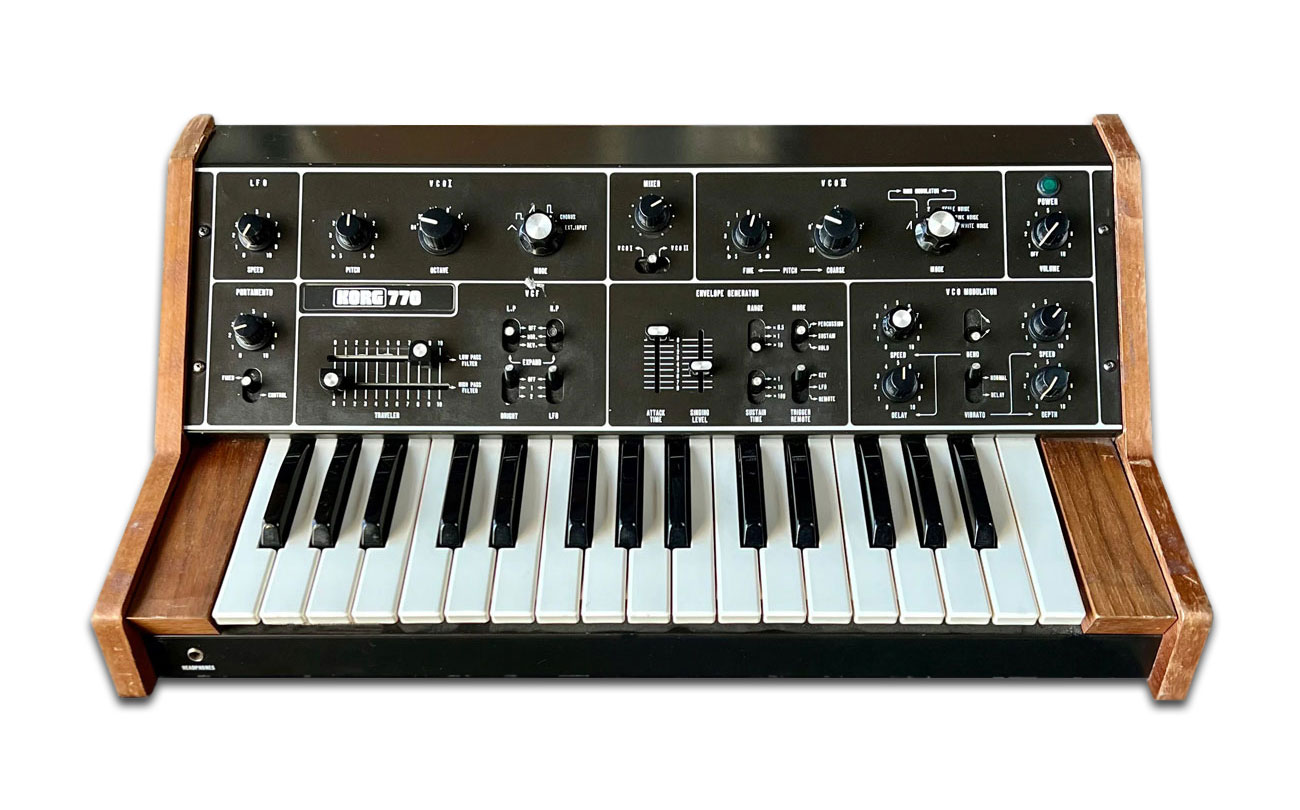KORG 770 - The Forgotten Gem of Analog Synthesis

In 1976, the Japanese company Korg introduced the Korg 770, a monophonic analog synthesizer that became one of the most unique instruments of its time. Although often overshadowed by more popular models like the Korg MS-20, it had its own character that set it apart from other analog synthesizers.
The Korg 770 was designed as a compact yet powerful instrument, offering rich sound synthesis possibilities, including two oscillators, two filters, a ring modulator, and several types of noise. Due to its unusual architecture and distinctive sound, it found a place in experimental electronic music and film scoring.
Historical Context – Where Does the Korg 770 Fit?
In the latter half of the 1970s, the world of analog synthesizers was evolving rapidly. Moog, ARP, Roland, and Korg competed for dominance in the market, with each manufacturer introducing innovations. The Korg 770 was released at a time when other iconic instruments like the Roland SH-1000 and ARP Axxe were emerging.
How Did the Korg 770 Differ from Its Competitors?
The Roland SH-1000 was the first Japanese synthesizer, but its sound flexibility was limited. The Korg 770 offered more modulation and a broader filter spectrum.
The ARP Axxe had an excellent filter but lacked the flexibility of two independent oscillators, which the Korg 770 provided.
The Moog Minimoog was stronger in bass tones, but the Korg 770 had unique metallic and experimental sounds thanks to its ring modulator.
Due to these characteristics, the Korg 770 was a perfect choice for musicians seeking an original and also less conventional analog sound.
Technical Structure – The Building Blocks of Korg 770’s Sound
Two Oscillators for Rich Synthesis
The Korg 770 features two independent oscillators, allowing complex sound layering.
• Oscillator 1 – Provides sawtooth, square, and pulse waves with PWM modulation capability.
• Oscillator 2 – Offers the same waveforms but can be synchronized with Oscillator 1 for
aggressive sounds.
• Ring Modulator – Allows the combination of two oscillators, creating metallic and experimental tones.
Two Filters for a Unique Sound Character
One of the Korg 770’s most appealing features is its two independent filters (Low-pass filter and High-pass filter) with the two horizontal slide controls labeled "Traveler" for controlling the cutoff frequencies.
By combining these filters, the Korg 770 could produce an unusual frequency spectrum distinct from other monophonic synthesizers of the time.
Noise Generators and Modulation
The Korg 770 included several types of noise, which was rare at the time.
• White noise – Classic white noise for percussive sounds.
• Pink noise – Softer noise for ambient effects.
• Scale noise – A unique type of noise that added an experimental character to the sound.
Additionally, the Korg 770 featured two LFOs, allowing complex modulation of oscillators and filters.
Use of the Korg 770 in Music Production
Although not as widespread as the MS-20, the Korg 770 appeared in experimental studios, film scores, and avant-garde electronic compositions.
Jean-Michel Jarre used the Korg 770 to create floating synthetic textures that appeared on his early albums. Vangelis utilized it for atmospheric effects in film music. Tangerine Dream experimented with its metallic sounds, which became part of their live performances.
Due to its flexibility and unconventional features, the Korg 770 was ideal for musicians exploring new sonic possibilities.
Impact of the Korg 770 on Other Synthesizer Models
Although the Korg 770 had a short lifespan on the market, some of its technologies influenced later models.
• The Korg MS-20 adopted its filter structure but added more modulation options.
• The Korg Mono/Poly refined the concept of multiple oscillators in a monophonic mode.
• The Korg Poly-800 later incorporated some digital noise generators inspired by the
Korg 770's technology.
This means the Korg 770 was a pioneering model that paved the way for the development of Korg synthesizers in the 1980s.
Modifications and Modern Uses of the Korg 770
Even today, some musicians maintain modified versions of the Korg 770 to enhance its capabilities. Popular modifications include:
• Additional CV/Gate outputs – For integration with modular systems.
• External LFO input – Expanding modulation options.
• Filter replacement – Some modifications substitute original filters with alternative circuits
for a new sound character.
Despite its modest size, the Korg 770 has become a collector's item, offering unique analog characteristics unavailable in modern digital instruments.
Additional Musicians Who Used the Korg 770
The Korg 770 found its place not only in experimental electronic music but also in new wave, synthetic pop, and progressive music. Among additional users were:
• Phil Oakey (Human League) – Used early analog synthesizers to shape dark, synthetic new
wave sounds.
• Michael MacNeil (Simple Minds) – Early keyboard sections in the band's production included
analog instruments, including the Korg 770.
• Leo Abrahams – British musician experimenting with sound synthesis and analog effects.
• Gary Numan – Pioneer of synthetic pop, known for his work with analog synthesizers.
• Global Citizen – Electronic band incorporating the Korg 770 in production and live performances.
• Terry Riley – Minimalist musician experimenting with analog equipment.
• Rick Wakeman (Yes) – Progressive rock keyboardist occasionally using analog Korg
synthesizers in arrangements.
• Richard Barbieri (Japan, Porcupine Tree) – Recognized for his creative approach to synthetic
sound design.
Conclusion
The Korg 770 is a forgotten gem of analog synthesis, offering unique sound possibilities through its two oscillators, two filters, ring modulator, and several types of noise. Its unusual architecture and characteristic sound make it one of the most fascinating analog synthesizers of the 1970s, still deserving the attention of musicians and collectors.
| |
|
|
|
|
|
|
|
|


